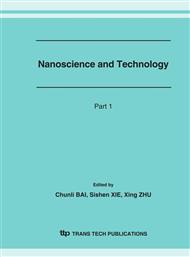p.705
p.709
p.713
p.717
p.721
p.725
p.731
p.735
p.739
Microcontact Printing of Multiproteins on the GA Modified Glass Substrate and Its Applications in the Research of Immunoassays
Abstract:
Microcontact printing (μCP) is a newly developed bioresearch technique applied in many fields such as absorption of proteins, adjunction and growth of cells and so forth, because of the controllable structure of its patterned materials. Further experiments showed that the microcontact printed proteins and cells can keep their bioactivity, which provides a feasibility of bio-molecule or cell analysis. The self-assembled molecules of μCP make molecule-scaled reactions possible, which have much higher accuracy compared with large amount reactions in solutions. In this article we first modified the chemical treated slide with APTES (3-aminopropyltriethoxysilane) to form AP-glass substrate, then with GA (glutaraldehyde) to form a GA-AP-glass substrate, and at last used XPS (X-ray Photoelectron Spectroscopy) technique to show the chemical structure changes of the surface molecules. Next, using μCP,we patterned chicken IgG (Ag1) and rabbit IgG (Ag2) onto the GA-APTES-glass substrate in vertical directions. After incubating the substrate with BSA (bovine serum albumin, a kind of protein) to block the blank place, we exposed the substrate to Anti-Chicken-IgG-FITC (Ab1) and Anti-Rabbit-IgG-TRITC (Ab2). Because of the specific binding between Ab and Ag, through fluorescence microscopy we could see the two-colored fluorescence images on the GA-AP-glass substrate, in which the different colored strands were vertical patterned.
Info:
Periodical:
Pages:
721-724
Citation:
Online since:
March 2007
Price:
Сopyright:
© 2007 Trans Tech Publications Ltd. All Rights Reserved
Share:
Citation:


